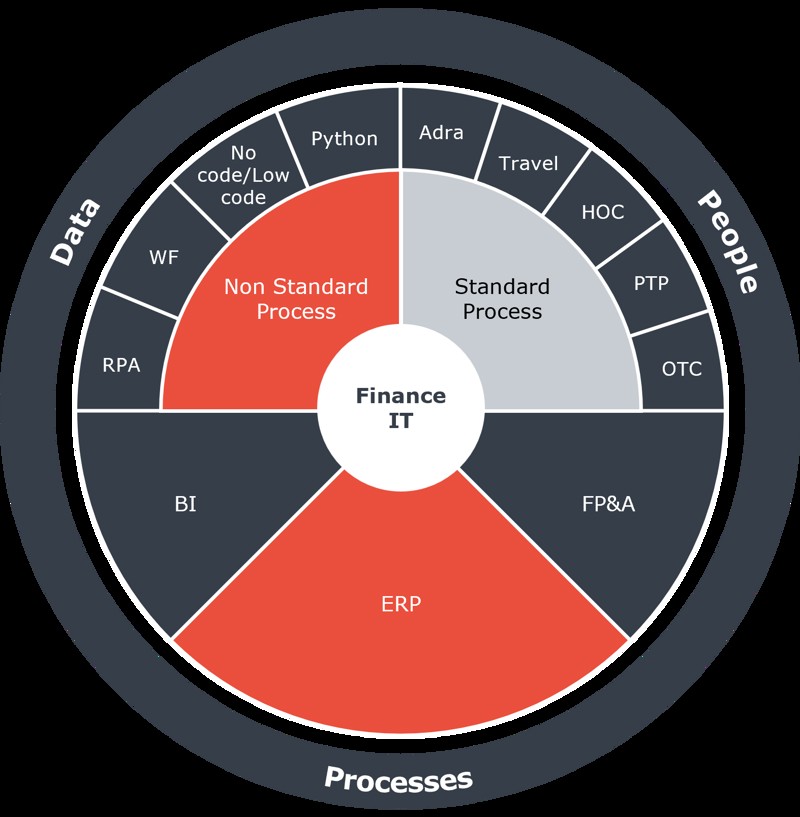They don't brag about it. But right now, Hårklinikken is one of Denmark's fastest growing enterprises. Therefore, they have, in recent two years, prepared for continued growth with a comprehensive, cross-border ERP project. A project that has included implementation of the ERP system Dynamics 365 Business Central, finance modules from Continia, integration between ERP and Shopify webshop & POS, as well as inventory scanners. And this article is about their learnings along the way.
More specifically, you can read about why it's a good idea to:
- Allocate time and budget for optimised integrations an controls when making a Shopify integration
- Pressure test your roll-out strategy though it seems a no-brainer
- Appoint in-house super users of the ERP system to ensure successful embedding.
Before presenting the experience gained from the ERP project, it is, however, important to understand how Hårklinikken services its customers and creates sale.
As it is, Hårklinikken has different kinds of customers. Some receive treatment of their hair and scalp customised by clinical experts over a period of time in one of Hårklinikken's clinics. Some are frequent buyers and fans of common hair products developed by Hårklinikken and sold through the webshop as online sales.
But the distribution of the two customer groups differs distinctly from one country to another where the enterprise has its clinics. In Denmark, 50 per cent of total sales are online, in Dubai 90 per cent of total sales takes place in the clinic, while 90 per cent of sales are online in the States.
Therefore, the bookkeeping entries of various turnover groups - such as online product sales, clinics' POS sales, consultations, discounts, campaigns, etc. - required a transfer of more detailed data to the ERP systems than a Shopify standard integration could provide.
However, the launch pad for Hårklinikken's ERP project was a combination of their existing inventory system being forced to be phased out due to 'sunset', the rapid growth challenging the management of the global inventory, and the transition to PE ownership meaning stricter requirements for the group accounts.
It was, in other words, a perfect storm and therefore Hårklinikken suddenly had to act quickly. Muvch has happened since then, and the ERP project has resulted in the implementation of the ERP system Dynamics 365 Business Central and financial modules from Continia as an integration between ERP and the Shopify webshop and POS, as well as inventory scanners.
Now, let's proceed with the experience gained following the completion of the ERP project.
1. Be aware that a Shopify standard integration will rarely do the work
Shopify offers a free standard integration in collaboration with Microsoft. And though it's comprehensive, you should expect to code special features, for example, via the code language AL for Business Central. Since business logics are often lacking in the standard integration.
In the case of Hårklinikken, the standard integration didn't, for example, support a different bookkeeping of physical sales in the clinics than of online sales. Furthermore, the standard integration is built without any controls and validations, which may have unfortunate consequences.
If you yourself are faced with a Shopify integration, it is thus a good idea to have some controls designed for validating, for example, VAT and amounts incl. VAT before the bookkeeping as such. This may, in fact, save you both time and grey hair.
And if you use a cloud version of Dynamics 365 Business Central, it could be an advantage to include a manual validation every time a new update of the Shopify integration is rolled out and before your bookkeeping is initiated again. If your bookkeeping is on automatic pilot, extremely much checking and extra work need to be done if the logics behind the VAT calculation has suddenly been changed.
Hopefully, the automated controls will find the error, but ... what if?
At Hårklinikken, we have solved this by making a BI report that reconciles turnover and VAT between Business Central and Shopify, making it easy to follow up on errors and to document the turnover in connection with month-end closing and auditing.
The most significant learning here is the importance of including in your overall budget a budget for adjustments of specially designed integrations and controls in support of your specific needs.
Last - but definitely not least - much is to be gained by reviewing the processes, rights, data structure, etc. of the system with which you want to integrate before starting the integration. Otherwise, it will most likely be an unnecesarily tough and costly affair to make the integration.
It may, for example, give rise to problems if you employees can register a sale as free text at the till. How is the ERP system to enter this? Or if you sell a package solution consisting of three articles and the articles figure only individually in your inventory. How is the ERP system to recognise the package solution and enter the sale?
By reviewing your processes, rights, data structure, etc., you find out whether your processes follow a structure that can easily be turned into a formula to be used for the integration.
Or you find out that your processes are chaotic and that you need to make a formula before starting the integration.
"The process implementing Dynamics 365 Business Central in Hårklinikken has been well-structured and gradual and is now approaching completion. Six companies as well as master data accounts have been implemented, and now the implementation is being completed for the last three groups of clinics in the US, Dubai and Iceland. Basico's role as a project manager and advisor throughout the process has been decisive, and they have handled the process with a steady hand. And the speeding up of the integration for the remaining three groups of clinics in the US, Dubai and Iceland bears witness to a proactive approach to meet our need for a fast and efficient transition to the new .”
2. Make sure to have considered several roll-out strategies
Many roads lead to Rome though one of them seems more obvious than others. Therefore, it could be an advantage to consider several roll-out strategies if you are to implement more processes and systems just like Hårklinikken.
We rolled oud all the processes company by company. But we could also have done it process by process across the companies. Especially in this case where Hårklinikken's former financial management system didn't have any inventory processes. Unfortunately, most companies forget to challenge the system implementation sequence because the natural thing seems to do it company by company.
Since Hårklinikken is partly owned by a private equity fund and is, as mentioned, undergoing growth, Finance experienced increased reporting and consolidation requirements. So the finance employees actually performing the reporting would have had another process rolling out the reporting process in all countries at once. And it would probably have given more peace to work, before proceeding with the remaining processes.
Nevertheless, Hårklinikken chose a roll-out company-by-company.
Among other things because Hårklinikken needed a replacement for the inventory system used by the production company as quickly as possible. Since the inventory system was suddenly removed from the market due to its acquisition by a competitor.
Furthermore, much change and restructuring occurred in, for example, Shopify. And this meant that it would have been extremely difficult to create progress regarding the commodity processes if the roll-out hadn't been done company by company.
With the benefit of hindsight, the ideal would probably have been a hybrid strategy invoving the best from the two worlds, where Hårklinikken had begun by rolling out Finance across the border and, subsequently, continued rolling out the commodity processes company by company.
3. Appoint in-house super users to support the embedding
Your super users are key to embedding your ERP system. Since after the implementation, the ERP consultants will proceed with their next project.More often than not, it will still be possible to be supported, but your project participants and especially your super users will be key to embedding the ERP solution in the company.
That's why it's important to talk about and clarify the roles of your appreciated project resources after go-live. So that they know what to return to and can see themselves play an important role in the embedding of the ERP system and help make learning and knowledge be rooted throughout the organisation.
If, for example, you don't have a super user acting as in-house support, there is a risk that all your employees will write about the same thing to your ERP advisor - and despite this, the knowledge is not embedded in the company next time the challenge arises.
Therefore, much business value is to be had by agreeing with your ERP supplier to appoint one in-house person through whom all dialogue with your ERP supplier should pass - to ensure internal sparring, embedding of knowledge, and efficient collaboration.
”The next step consists in building reporting and consolidation on top of the Dynamics 365 Business Central installation, thereby further strengthening Hårklinikken's ability to gather meaningful insight across all companies and clinics. Overall, we have now assumed a robust approach to the implementation of Dynamics 365 Business Central and are well-positioned to use our improved business processes and efficiency gains across countries and companies."
Competences – full-circle
When helping a Finance function digitalise and automate, we take pride in combining the applications and tools that will meet your specific demands. In a way so that the solution supports the data, processes and people working hard behind the lines.

Basico's digitalisation circle

Would you like more knowledge about ERP projects?
Do you need sparring?
No matter whether you are to launch an ERP project, upgrade your existing ERP system, or need sparring about optimised integrations with, for example, Shopify, many issues need to be considered.
So if you need to clarify the possibilities presented by your current ERP system, then don't hesitate to contact Director Thomas Malmros or Manager Kristian Schønning for an informal dialogue.

 en
en
 da
da




